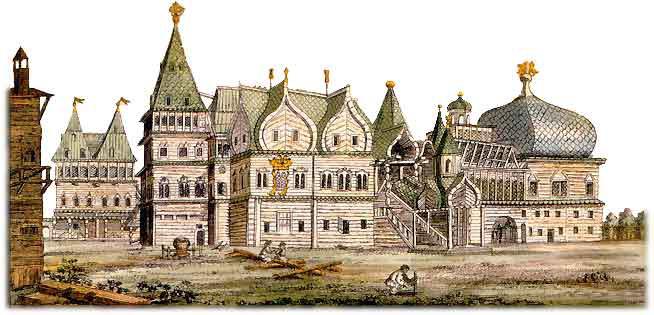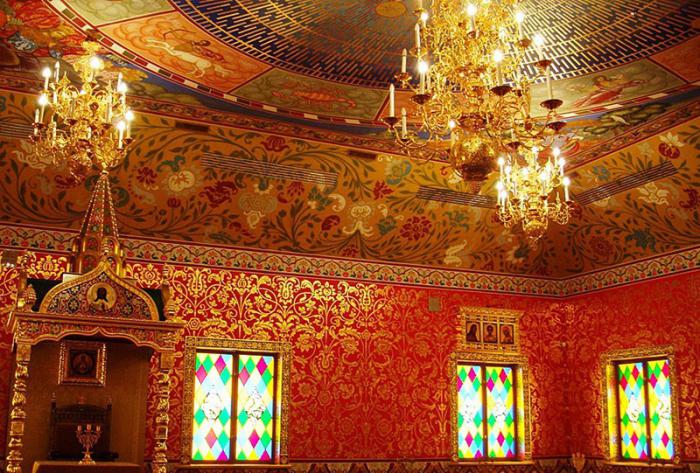The village of Kolomenskoye near Moscow was once the patrimony of the Russian tsars. Now this place is the territory of the State Architectural Reserve. On a vast area of almost four hundred hectares, there are suburban monasteries and churches, as well as palaces: the house of Peter the Great, transported here from Arkhangelsk, and, in fact, the mansions of Russian tsars - Alexei Mikhailovich, nicknamed Tishayshim, and Fedor Alekseevich. Most of the reserve is a park and nature untouched by man: ravines, forest. In the southeastern part, it goes to the embankment of the Moscow River. So you can sail to the Tsar’s palace in Kolomenskoye on a pleasure boat. It is good to look here during the festivities for Christmas or Shrovetide. Then in Kolomenskoye theatrical performances, sleigh rides and other entertainment are held. There are several ancient churches in the reserve. But in this article we will focus specifically on the palace of the Russian tsars.
A bit of history
Russian princes loved Kolomenskoye. The palace stood in this place as early as the fourteenth century. Therefore, the surroundings of the village were decorated with churches of the "metropolitan scale". For example, Basil III erected a tent-shaped temple of the Ascension in 1532. He lived in Kolomenskoye and Ivan the Terrible. Chronicles report that here, in his palace, he celebrated name days. But this place was especially fond of Tsar Mikhail Fedorovich. He ordered the expansion of the mansions, in fact, to build a new palace on the old site. On September 17, 1640, the king celebrated a housewarming party with the boyars. This place was also loved by the heir, Alexei Mikhailovich. An avid hunter, he repeatedly visited this suburban residence. Upon accession to the throne, he started a new construction.
Kolomenskoye: the palace of Alexei Mikhailovich
As early as 1649-1650, as well as 1657, the king was adding new premises to the old ones - on the occasion of the birth of children. But it was all wrong. The king wanted to create an integrated ensemble, and not a system of huts connected by transitions. In 1667, the first stone was laid in the construction of what later contemporaries would call the "eighth wonder of the world." It should be noted that the palace was built by Alexei Mikhailovich in Kolomenskoye ordinary people - carpenters Semyon Petrov and Ivan Mikhailov. A year later, the decoration of wooden walls, windows and facades with skillful carvings began. In the spring of 1669, materials for decoration (gold leaf and paints) were written out from abroad, and the master himself, an Armenian from Persia, Bogdan Saltanov. The icon painter Simeon Ushakov supervised the finishing work. The painting of ceilings and walls, the gilding of tents lasted about two years. Finally, in 1673, the master of the Armory, Peter Vysotsky, installed a clock on the gate tower and arranged the mechanics of growling lions.

Perestroika Fyodor Alekseevich
After the death of the Quiet, the new king took up Kolomenskoye. The palace was rebuilt again. Fedor Alekseevich ordered the construction of a new refectory, which was connected to the personal chambers of the king by the gallery. This dining room was built by the serf boyar Sheremetev Semyon Dementyev. The “Golden Gates” were also erected, which, in the absence of the king in Kolomenskoye, were hung with cloth so as not to fade. Roaring lions at the throne, exterior decorations and the interior were repaired. The restoration was completed in the spring of 1682. About two years later, work went on to repair household outbuildings, decorating roofs and painting rooms. Due to the riot of the archers, barracks were erected for personal protection - only sixteen huts. In 1685, the entrance gate was reinforced with English tin and iron, and a new clock was set up.
The era of Peter the Great and Kolomenskoye
The palace, with the transfer of the capital to St. Petersburg, began to gradually decline. Wood is not a very resistant material. Subsequent empresses also did not pay enough attention to this suburban residence. Anna Ioannovna, however, ordered to keep her “in good charity,” but she did not deign to allocate funds for this. In the autumn of 1762, Catherine II visited Kolomenskoye. She ordered a repair estimate. The document was submitted in 1764. But the empress, instead of reconstruction, ordered the construction of a new palace on the site of the destroyed outbuildings. In May 1767, Catherine was informed that stairs and roofs began to crumble in old mansions. Then the empress ordered to dismantle the palace of Alexei Mikhailovich in Kolomenskoye, and clean the place. The exact date of destruction is unknown. Karamzin in “Poor Liza” (1792) mentions the village of Kolomenskoye with a high palace. On the site of a wooden mansion, a four-story building in the style of classicism was erected. But even a century later it was destroyed.

Museum "Kolomenskoye"
The restoration of the historical site began with the initiative of the famous artist-restorer P. Baranovsky. He proposed in 1923 to build an open-air museum on the territory of the former estate of Russian tsars dedicated to the wooden architecture of Russia. This explains the presence of Peter the Great’s house in Kolomenskoye . In it, the Tsar Reformer lived on Markov Island for about two months, personally monitoring the construction of the defensive fortress of Arkhangelsk. Baranovsky restored the interior of the house, the Moss Tower of the Sumy prison, passage gates of the Nikolo-Korelsky Monastery, the Church of St. George the Victorious and other monuments of wooden architecture. Gradually, other buildings began to be reconstructed, which were already directly related to Kolomenskoye: the Vodovzvodnaya tower, the Fryazhsky cellar and the church of St. George with a bell tower. And in 1990, the idea came up to recreate the summer palace of Alexei Mikhailovich.
Reconstruction
Although the royal mansions of the seventeenth century were completely wiped off the face of the earth, many lithographs and drawings remained, which depict in detail the interiors and the exterior decoration of this "eighth wonder of the world." In addition, the drawings of the builders of the royal chambers were preserved . Since centuries-old oaks and linden trees had already grown on the site of the palace, it was decided to reconstruct the building in another place nearby, in the village of Dyakovskoye. The construction was completed in 2010. The wooden palace of Alexei Mikhailovich was replaced by a reinforced concrete structure, lined with logs. Despite the fact that she changed the initial orientation to the cardinal points, tourists can see the chambers of the king and the empress, the chambers of the prince and princesses. The ceremonial dining room, in which covered galleries lead from different wings of the palace, leaves a special impression.
Museum: opening hours, cost
Despite the fact that the entire palace was built in the first years of our century, an excursion to Kolomenskoye will not disappoint anyone. After all, all the interiors were recreated with extreme care, completely copying the preserved drawings and drawings. The chambers are equipped with unique lamps, mica windows and furniture. In twenty-four interiors of the palace, the personal life and officialdom of Russian sovereigns of the pre-Petrine era appear before the eyes of tourists.
Entrance to the park is free. But at the exhibition - for a fee. If you come to Kolomenskoye for the whole day, it is better to purchase a single ticket - it costs 400 rubles and gives you the right to visit various premises. The exposition is open daily except Monday. Entrance to the palace costs 250 rubles.